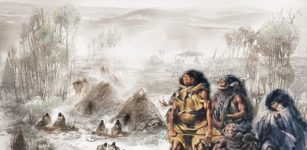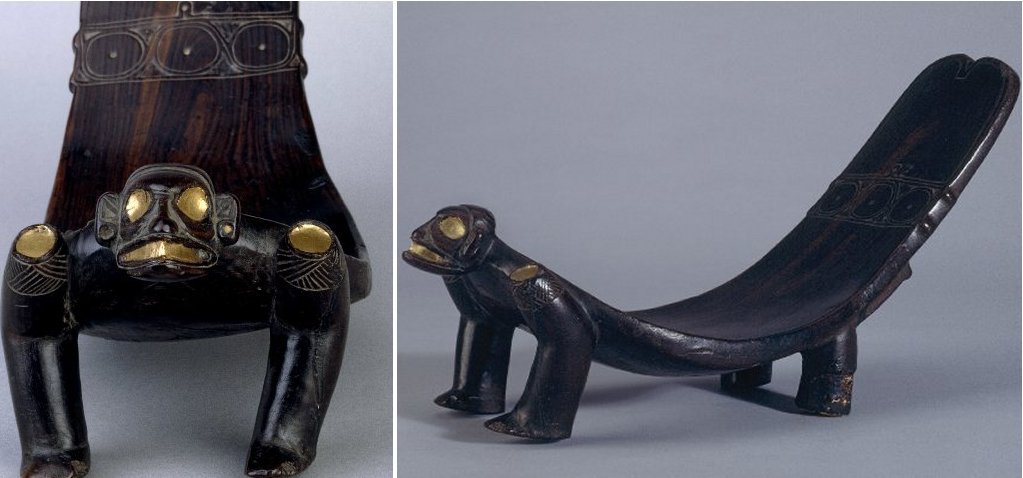Curious Ritual Wooden ‘Duho’ Stool Of Ancient Taino People
A. Sutherland - AncientPages.com - This ceremonial four-legged wooden stool known as 'duho' originates from Santo Domingo, Dominican Republic, and dates back to 1200– 1500 AD.
The grimacing, bizarre face of seat's half-human and half-animal creature. Image credit: British Museum
Scholars have long argued over the function of the Taino stool, which is not entirely known. However, the duho' was definitely not any domestic object for ordinary people.
Pre-Columbian duhos have their roots in the ancient tradition of the Taino culture, indigenous peoples of the Caribbean, what is today Haiti and the Dominican Republic), Puerto Rico, and the Bahamas.
People believed the "duho" stool possessed great power. It was carved into the shape of a weird, male creature, half-animal and half-human, with a large mouth, wide ears, and two arms, which form the front two legs of the stool. From there, a broad curve of wood sweeps upwards, supported by two more legs.
Underneath the creature and between the hind legs were carved male genitals, as described by researchers.
Many believe Taino shamans and chiefs used the artifact (only about the size of a footstool) during ceremonial communication with the spirit world.
According to José R. Oliver, a Puerto Rican/Catalan archaeologist specializing in the archaeology of the Caribbean, the duho was not a piece of furniture but rather a symbolic location of where the chief would stand, most probably a symbolic portal and a vehicle to the supernatural world.
A hallucinogenic snuff "Cohoba" prepared from the charred seeds of the cohoba tree and inhaled in a Y-shaped, twin-nasal pipe was used as a mind-altering substance. The effect of this snuff was experienced within half an hour and lasted from two to three hours, giving diverse special effects such as weird sounds, voices, and dream-like hallucinations.
By sitting on the duhos, chiefs could come in contact with the realm of the cemi (the spirit of the ancestor) and publicly display their power over the spirit world and their ability to manage and control the invisible forces governing the natural world as well as human affairs.
The Taino people believed they lived in parallel with an invisible world of ancestors and gods, from whom their leaders could seek knowledge of the future.
The Europeans who had an opportunity to see the Taino duho called it "the 'wood of life' ("lignum vitae"), which was believed to treat successfully many illnesses, from sore throats to syphilis.
Wooden four-legged stool carved in anthropomorphic form and inlaid with gold; called duho. Image credits: British Museum
The wood of the duho - smooth and perfect - originated from the Caribbean and was intentionally chosen and had remarkable qualities. It was so unusually dense that it could sink in water.
Not much is known about the Taino people. They lived in small settlements of a few thousand people, in large circular houses, each accommodating perhaps a dozen families, clustered around a central square. Their life was ruled by centers of power whose leaders fought, negotiated, and allied among themselves.
The Tainos' contact with the Europeans was fatal. Consequently, it brought enslavement, disease, and finally, the collapse of indigenous Taino society.
Many believe the artifact (only about the size of a foot stool) was used by Taino shamans and chiefs during ceremonial communication with the spirit world.
Written by – A. Sutherland AncientPages.com Staff Writer
Updated on July 22, 2022
Copyright © AncientPages.com All rights reserved. This material may not be published, broadcast, rewritten or redistributed in whole or part without the express written permission of AncientPages.com
Expand for referencesMore From Ancient Pages
-
 3,300-Year-Old Hittite Cuneiform Tablet Found In Büklükale Deciphered!
Archaeology | Apr 2, 2024
3,300-Year-Old Hittite Cuneiform Tablet Found In Büklükale Deciphered!
Archaeology | Apr 2, 2024 -
 Fossil Of Prehistoric Saber-Toothed Cat Found In Texas
Fossils | Jun 11, 2024
Fossil Of Prehistoric Saber-Toothed Cat Found In Texas
Fossils | Jun 11, 2024 -
 North America Was Settled By Previously Unknown People – DNA From A 11,500-Year-Old Skeleton Reveals
Archaeology | Jan 3, 2018
North America Was Settled By Previously Unknown People – DNA From A 11,500-Year-Old Skeleton Reveals
Archaeology | Jan 3, 2018 -
 Food Insecurity Led To An International Conflict 2,000 Years Ago
Archaeology | Sep 22, 2022
Food Insecurity Led To An International Conflict 2,000 Years Ago
Archaeology | Sep 22, 2022 -
 Mysterious Ancient Ruins Of Engaruka – Why Was The Site Abandoned?
Featured Stories | Apr 18, 2017
Mysterious Ancient Ruins Of Engaruka – Why Was The Site Abandoned?
Featured Stories | Apr 18, 2017 -
 Secrets Of Neanderthals’ 130,000-Year-Old Carved Bear Bone Found In The Carpathian Mountains
Archaeology | May 24, 2024
Secrets Of Neanderthals’ 130,000-Year-Old Carved Bear Bone Found In The Carpathian Mountains
Archaeology | May 24, 2024 -
 Tuatha De Danann: Mythical Race Of God-Like Beings With Supernatural Abilities In Celtic Mythology
Celtic Mythology | Feb 26, 2019
Tuatha De Danann: Mythical Race Of God-Like Beings With Supernatural Abilities In Celtic Mythology
Celtic Mythology | Feb 26, 2019 -
 Fascinating Geghard Monastery: Rock-Cut Secret Caves, Passages And Hundreds Of Monk Cells
Civilizations | Aug 3, 2021
Fascinating Geghard Monastery: Rock-Cut Secret Caves, Passages And Hundreds Of Monk Cells
Civilizations | Aug 3, 2021 -
 Unexplained Disappearance Of East Balkan Civilizations – Scientific Disagreement – Part 2
Ancient Mysteries | Apr 30, 2018
Unexplained Disappearance Of East Balkan Civilizations – Scientific Disagreement – Part 2
Ancient Mysteries | Apr 30, 2018 -
 Kaupang – Flourishing Viking Town – A Commercial Hub And Transit Port For North Sea Trade
Featured Stories | Feb 2, 2023
Kaupang – Flourishing Viking Town – A Commercial Hub And Transit Port For North Sea Trade
Featured Stories | Feb 2, 2023 -
 Statue Heads Of Dionysus And Aphrodite Discovered In The Ancient City Of Aizanoi
Archaeology | Dec 12, 2023
Statue Heads Of Dionysus And Aphrodite Discovered In The Ancient City Of Aizanoi
Archaeology | Dec 12, 2023 -
 2,500-Year-Old Large Untouched Scythian Burial Ground Unearthed In Khakassia, Siberia
Archaeology | Oct 6, 2020
2,500-Year-Old Large Untouched Scythian Burial Ground Unearthed In Khakassia, Siberia
Archaeology | Oct 6, 2020 -
 Unique 2,800-Year-Old Ivory Object Unearthed At Hattusa
Archaeology | Nov 14, 2023
Unique 2,800-Year-Old Ivory Object Unearthed At Hattusa
Archaeology | Nov 14, 2023 -
 God Dagda – A Powerful Leader Of The Tuatha De Danann In Celtic Mythology
Celtic Mythology | May 30, 2020
God Dagda – A Powerful Leader Of The Tuatha De Danann In Celtic Mythology
Celtic Mythology | May 30, 2020 -
 Mystery Of Ancient Gaza Wine – New Insight
Archaeology | Apr 26, 2023
Mystery Of Ancient Gaza Wine – New Insight
Archaeology | Apr 26, 2023 -
 Struggle To Get Mail On Time Has Lasted More Than 5,000 Years – Part 1
Featured Stories | Jul 30, 2017
Struggle To Get Mail On Time Has Lasted More Than 5,000 Years – Part 1
Featured Stories | Jul 30, 2017 -
 Viking Era Sword Discovered By Young Girl
Archaeology | Oct 5, 2018
Viking Era Sword Discovered By Young Girl
Archaeology | Oct 5, 2018 -
 Our 7-Day Week Can Be Traced To Babylonians Who Started Using It 4,000 Years Ago
Ancient History Facts | Nov 7, 2016
Our 7-Day Week Can Be Traced To Babylonians Who Started Using It 4,000 Years Ago
Ancient History Facts | Nov 7, 2016 -
 Italian Sailors Knew Of America 150 Years Before Christopher Columbus – Ancient Documents Reveal
Archaeology | Oct 8, 2021
Italian Sailors Knew Of America 150 Years Before Christopher Columbus – Ancient Documents Reveal
Archaeology | Oct 8, 2021 -
 Fairies Weren’t Always Cute – They Used To Drink Human Blood And Kidnap Children
Featured Stories | Oct 15, 2022
Fairies Weren’t Always Cute – They Used To Drink Human Blood And Kidnap Children
Featured Stories | Oct 15, 2022



